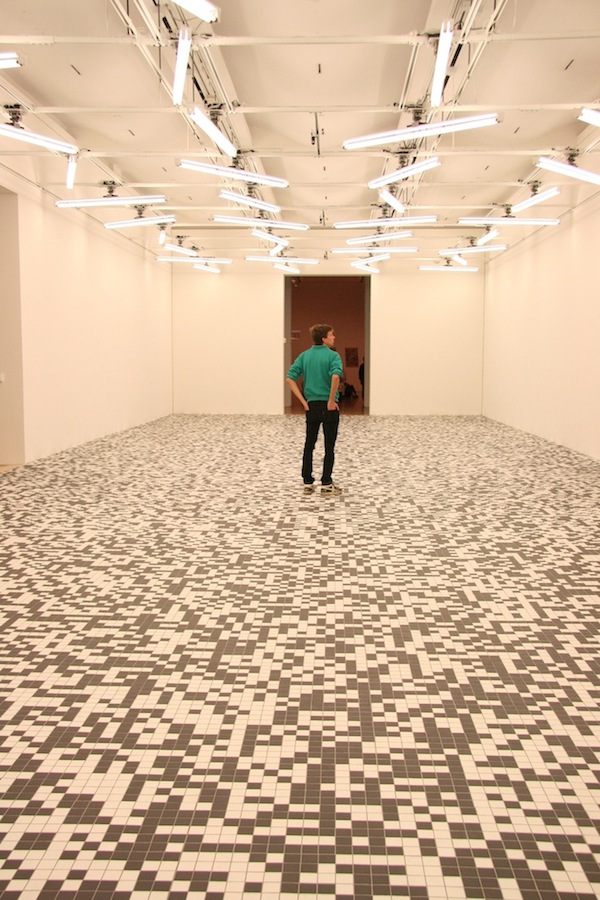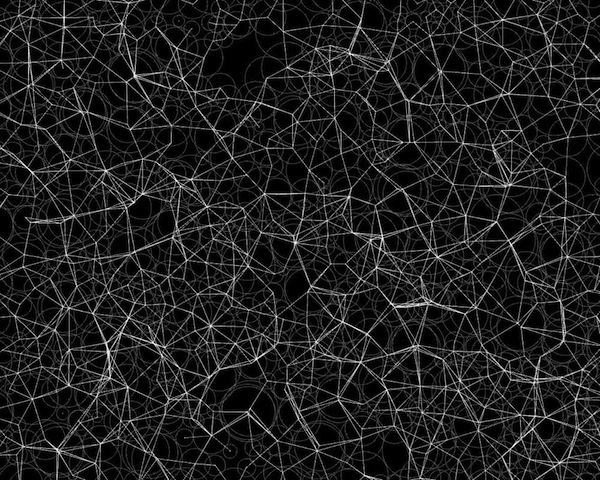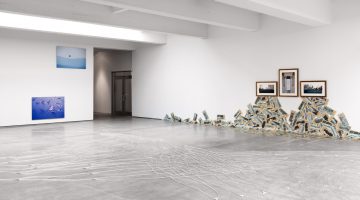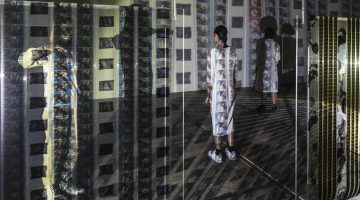The San Francisco Museum of Modern Art’s “Field Conditions,” curated by Assistant Curator of Architecture and Design Joseph Becker, is named after architect Stan Allen’s essay of the same name. Allen’s “field” is a landscape of “forces and not material,” the rule based systems at work in the universe (Allen 8). Installations, drawings and video by artists including Tauba Auerbach, Rafael Lozano-Hemmer, Daniel Libeskind, Ruth Jarman, and Joe Gerhardt. The works are tied to intensely rule-based fields, such as astronomy, architecture, computer science, and physics, and illustrate the field’s rules and functions. While the scale changes within the exhibit, “Field Conditions” shows the natural system’s (including our feeble human brains) propensity for order.
The most explicit example is C.E.B. Reas’ “Process 7”, a piece of a 18-part series of written rules demonstrated with simple software visualizations. There are components of “Process’” reality, which Reas refers to as The Library:
Forms
F1: Circle
F2: Line
Behaviors
B1: Move in a straight line
B2: Constrain to surface
B3: Change direction while touching another Element
B4: Move away from an overlapping Element
B5: Enter from the opposite edge after moving off the surface
B6: Orient toward the direction of an Element that is touching
B7: Deviate from the current direction
Elements
E1: F1 + B1 + B2 + B3 + B4
E2: F1 + B1 + B5
E3: F2 + B1 + B3 + B5
E4: F1 + B1 + B2 + B3
E5: F2 + B1 + B5 + B6 + B7
And rules specific to “Process 7”, combining parts of the components:
A rectangular surface filled with varying sizes of Element 1. Draw a line from the centers of Elements that are touching. Set the value of the shortest possible line to white and the longest to black, with varying grays representing values in between. Draw the perimeter of each Element as a black line and the center as a white dot.
As the work progresses in duration, the path of the two-dimensional lines are recorded temporally as the process unfolds. It looks like synapses forming. In the visualization of time and space, the rules from which the rule-based visualization is derived are difficult to discern, but new patterns emerge as connections are formed and fade. Shown simultaneously, you can see its mechanics and their growing effects.
Ruth Jarman, and Joe Gerhardt’s “20 Hz” visualizes the sounds from a “geo-magnetic storm occurring in the Earth’s upper atmosphere” (Semiconductor). The spectral, futuristic, and familiar sounds’ symmetry and repeating component parts are mesmerizing. These ringed waves are at the transition point between the silence of space and our seemingly fast-moving and chaotic world.

Nice jacket. Tauba Auerbach’s “50/50 Floor” Rafael Lozano-Hemmer’s “Homographies” at the San Francisco Museum of Modern Art.
The forces at work in Tauba Auerbach’s “50/50 Floor” (2008) and Rafael Lozano-Hemmer’s “Homographies” (2006) were apparently paired without the artists’ involvement. Auerbach’s conceptual piece fits the dimensions of the floor on which its black and white tiles are randomly laid. If you look long enough, imperfect patterns emerge in the floor, though that’s mostly your brain’s propensity to simplify and organize. It’s hard to focus on “50/50 Floor” as Lozano-Hemmer’s lights makes the tiles appear to undulate. The fluorescent lights of “Homographies” rotate in response to the visitors walking below them. The lights’ rules are the dominant system in the room, but without them the floor would be less fun. Fluorescent light is institutional, and it feels as though you under surveillance, but the light’s movement reveals an organic path and pattern of activity within the gallery; on a museum floor without vitrines, nearly everyone walks a straight line to the next gallery entrance.
“Field Conditions” shows the rules at work in the world around us, and teaches the viewer how to recognize them. Reas’ shows the evolution of rules’ effect on each other. Observing Auerbach’s “50/50 Floor” and Lozano-Hemmer’s “Homographies” is an opportunity to practice finding the patterns in your mind and the people around you. Each piece in the exhibit is only really differentiated by the scale of the process it visualizes. There’s a great reward in taking them all in and seeing how things work.
“Field Conditions” is on view at the San Francisco Museum of Modern Art through January 6, 2013.
-Kendall George
Citations:
Allen, Stan. “Article by Stan Allen.” Assemblage 41 (2000): 8.
Gerhardt, Joe, Ruth Jarman. 20 Hz. 2012. Semiconductor. 11 September 2012. http://vimeo.com/30668685
Reas, C.E.B. “Process Compendium,” Texts. Reas. 20 August 2010. Web 27 September 2012. http://reas.com/texts/processcompendium.html
Images, in order of appearance:
Reas, C.E.B. “Process Compendium (Introduction)”, Casey Reas. Vimeo. 2011. Web 30 September 2012. http://vimeo.com/22955812
Reas, C.E.B. Process 7 (detail), 2010; multimedia; dimensions variable. Image via archdaily. 30 September 2012. http://www.archdaily.com/255190/sfmoma-presents-field conditions/sfmoma_fieldconditions_04_cebreasdetail2/
Gerhardt, Joe, Ruth Jarman. 20 Hz. 2012. Semiconductor. 11 September 2012 http://vimeo.com/30668685
George, Kendall. Tauba Auerbach’s “50/50 Floor” Rafael Lozano-Hemmer’s “Homographies” at the San Francisco Museum of Modern Art. 2012.



